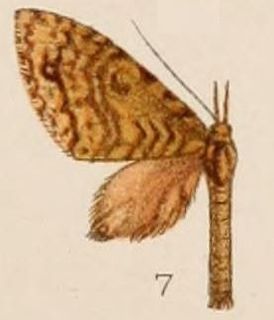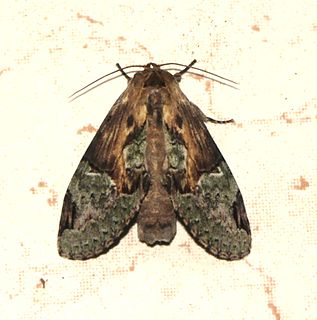
Teulisna is a genus of moths in the family Erebidae. The genus was erected by Francis Walker in 1862. They are found in Sri Lanka, India, Myanmar, Borneo and Java.

Carmara is a monotypic moth genus of the family Noctuidae. Its only species, Carmara subcervina, is found in Sri Lanka, Japan, Taiwan, Borneo and Australia. Both the genus and species were first described by Francis Walker in 1864.

Sauris is a genus of moths in the family Geometridae erected by Achille Guenée in 1857.

Chadisra bipars is a moth of the family Notodontidae. It was described by Francis Walker in 1862 and is found in the Indomalayan realm.

Teulisna tumida is a species of moth of the family Erebidae first described by Francis Walker in 1862. It is found in Borneo, Sumatra, China, India, Sri Lanka, Thailand and Taiwan.
Bitecta murina is a moth of the subfamily Arctiinae. It was described by Franciscus J. M. Heylaerts in 1891. It is found on Java.
Teulisna perdentata is a moth of the family Erebidae first described by Herbert Druce in 1899. It is found in south-western China and Malacca.
Eugoa vagigutta is a moth of the family Erebidae first described by Francis Walker in 1862. It is found on Borneo. The habitat consists of alluvial forests, forest on limestone, lowland dipterocarp forests and open coastal forests.

Athetis reclusa is a moth of the family Noctuidae first described by Francis Walker in 1862. It is found from Sundaland to New Caledonia and Fiji. The habitat consists of open areas from sea level up to 1,200 meters.
Nishada rotundipennis is a moth of the family Erebidae first described by Francis Walker in 1862. It is found on Borneo and Peninsular Malaysia and in Myanmar and the north-eastern Himalayas. The habitat consists of forests.
Tampea reversa is a moth in the subfamily Arctiinae. It was described by Francis Walker in 1862. It is found on Borneo and Java. The habitat consists of lowland areas and lower montane forests.
Teulisna chiloides is a moth in the family Erebidae. It was described by Francis Walker in 1862. It is found on Peninsular Malaysia, Sumatra, Borneo, Sulawesi and Sumbawa. It has also been recorded from Queensland, Australia. The habitat consists of lowland dipterocarp forests, alluvial forests and lower montane forests.
Teulisna curviplaga is a moth in the family Erebidae. It was described by Walter Rothschild in 1912. It is found on Peninsular Malaysia and Borneo. The habitat consists of lower montane forests.
Teulisna divisa is a moth in the family Erebidae. It was described by Francis Walker in 1862. It is found on Borneo.
Teulisna macropallida is a moth in the family Erebidae. It was described by Jeremy Daniel Holloway in 2001. It is found on Borneo. The habitat consists of upper montane forests.
Teulisna plagiata is a moth in the family Erebidae. It was described by Francis Walker in 1862. It is found on Borneo. The habitat consists of lower montane forests.
Teulisna reflexa is a moth in the family Erebidae. It was described by Jeremy Daniel Holloway in 2001. It is found on Borneo. The habitat consists of montane areas.
Teulisna steineri is a moth in the family Erebidae. It was described by Jeremy Daniel Holloway in 2001. It is found on Borneo. The habitat consists of montane and lowland areas.
Etanna basalis is a moth of the family Nolidae first described by Francis Walker in 1862. It is found in Borneo, Sri Lanka, Myanmar, Thailand, New Guinea, Australia, Vanuatu and Fiji.

Earias cupreoviridis, called the cupreous bollworm as a larva, is a moth of the family Nolidae. The species was first described by Francis Walker in 1862. It is found in African countries like Botswana, the Democratic Republic of the Congo, Eritrea, Ethiopia, the Gambia, Kenya, Nigeria, Sierra Leone, South Africa, Togo, Uganda, Zimbabwe to Asian countries like India, Sri Lanka, China, Japan, Korea, Philippines, Indonesia and Hong Kong.






